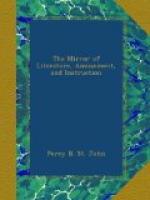Many regulations were, however, to be observed after the above initiatory ceremony, which we have given at length in consequence of its singularity. There existed a community or commonwealth, of “fallen angels” or spirits, with the various titles of kings, dukes, &c., prelates and knights, of which the head was Baal, “who, when he was conjured up, appeared with three heads, one like a man, one like a toad, and one like a cat.” The title of king conferred no extra power; indeed, Agares, “the first duke, came in the likeness of a faire old man, riding upon a crocodile, and carrying a hawk on his fist”—Marbas, who appeared in the form of a “mightie lion”—Amon, “a great and mightie marques, who came abroad in the likeness of a wolf, having a serpent’s taile, and breathing out and spitting flames of fire,” and was one of the “best and kindest of devills,” with sixty-five more of these master-spirits, enumerated in Scot, “appeared to be entirely and exclusively appropriated to the service of witches,” were alike possessed of nearly similar power, and had many hundreds of legions of devils (each legion 6,666 in number) at their command.
There were stated times for each rank of devils to be called on, for they aught not to be invoked “rashly or at all seasons;” and the following extracts from Reginald Scot are fully explanatory of the formalities to be observed on these occasions:—




